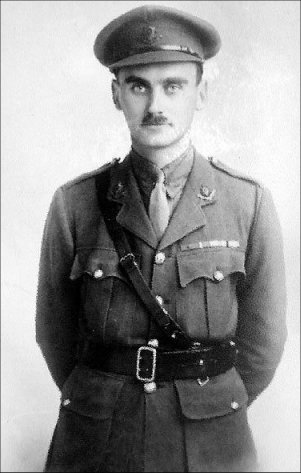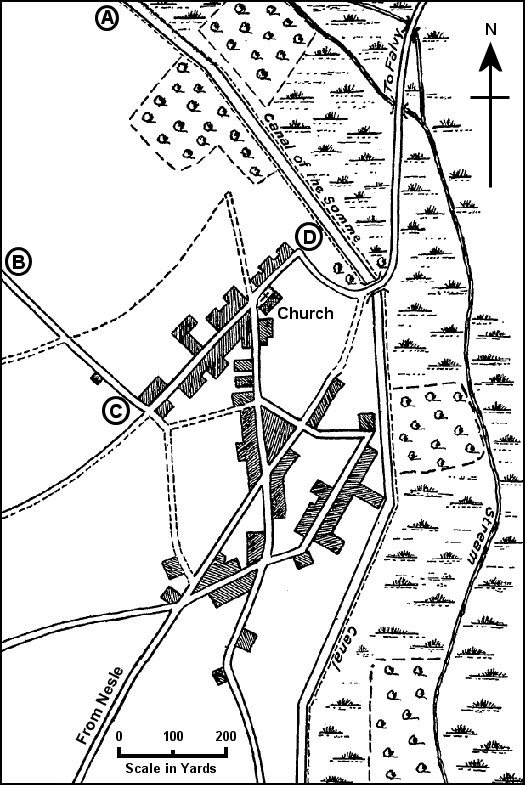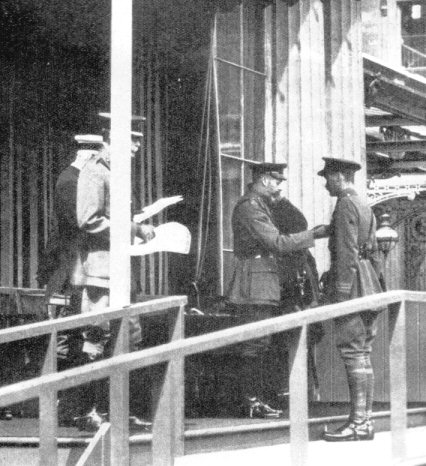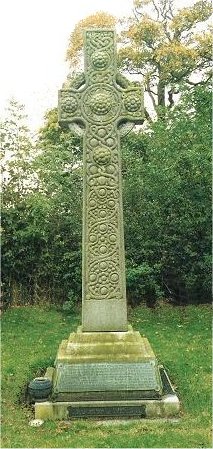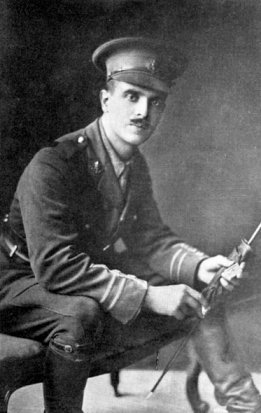Major (Acting Lieut.-Colonel) Frank Crowther ROBERTS V.C., D.S.O, O.B.E., M.C.
Frank Crowther Roberts was born on the 2nd June 1891 at Highbury, London, the son of the Rev. Frank Roberts, vicar of St. John, Southalll. After education at St. Lawrence College, Ramsgate and the Royal Military Academy Sandhurst, he was commissioned into The Worcestershire Regiment on the 4th March 1911 as a 2nd Lieutenant and in 1912 went with the 1st Battalion Worcestershire Regiment to Egypt. On the 3rd September 1914 he was promoted to rank of Lieutenant. In 1914, at the outbreak of War, his Battalion was moved to France in November 1914, where, after only three months in action he won the first of his distinctions, the D.S.O., for gallantry when leading a trench raid 1000 yards west of Neuve Chapelle. That gallant little exploit received prompt recognition. Within twenty-four hours Lieut. Roberts was awarded the D.S.O. Distinguished Service Order citation reads: "On the 3rd January, 1915, Lieutenant Roberts, with twenty-five men of the 1st Battalion, Worcestershire Regiment, attacked and captured by surprise, with complete success, a German sap-head situated about sixty yards in front, of our lines near Neuve Chapelle." After the battle of Neuve Chapelle he was Adjutant of the 1st Battalion Worcestershire Regiment on the 13th March 1915. On the 24th October 1916 he was promoted to be Brigade-Major of the 23rd Infantry Brigade (commanded by Colonel Grogan), and in that capacity gained the Military Cross for gallantry in the Battles of Ypres on the 31st July 1917, for daring personal reconnaissances made by him during the day under heavy fire. Military Cross citation reads: "For conspicuous gallantry and devotion to duty. During two days' very hard fighting he showed marked skill and resource under adverse circumstances, and throughout kept a firm grip of the situation. It was largely due to his excellent staff work that the brigade was able to hold its objectives against heavy counter-attacks; and, in addition, the daring personal reconnaissances which he made under heavy fire were of the greatest value to headquarters throughout the whole action." (London Gazette 9th January 1918) During the ensuing winter on the 24th October 1917 he was appointed to the temporary command of his old Battalion, The 1st Battalion Worcestershire Regiment and given the rank of Acting Lieut.-Colonel. He was then only twenty-six years of age—the youngest officer ever gazetted to the command of a Battalion of the Worcestershire Regiment. |
Major F. C. Roberts V.C. (later Major-General) |
During March 1918 the 1st Battalion Worcestershire Regiment were moved forward in to the line of the River Somme in order to hold the postion from advancing German forces. It was during this time that Acting Lieut.-Colonel Roberts would win his Victoria Cross for gallantry.
His citation reads:
"During continuous operations which covered over twelve days Lt -Col Roberts showed most conspicuous bravery, exceptional military skill in dealing with the many very difficult situations of the retirement, and amazing endurance and energy in encouraging aud inspiring all ranks under his command. On one occasion the enemy attacked a village and had practically cleared it of our troops, when this officer got together an improvised party and led a counter-attack which temporarily drove the enemy out of the village, thus covering- the retirement of troops on their flanks who would otherwise have been cut off. The success of this action was entirely due to his personal valour and skill." (London Gazette 8th May 1918)
Below is an account of the 1th Battalions actions during the defence at the village of Pangny and how Lieut.-Col. Roberts won his Victoria Cross.
Counter attack at Pargny (23rd March 1918)
The 8th Division, which included the 1st Battalion Worcestershire Regiment, was in reserve when the great German offensive was launched in March 1918. During the first twenty-four hours of the fighting it was obvious that reinforcements would be needed on the front of the Fifth Army, and the 8th Division then in Flanders, was ordered to entrain for the Somme Front.
The first sign of the great German attack which reached the 1st Worcestershire at Moringhem had been an urgent warning order on March 21st that all units of the 24th Brigade were to be ready to move at five hours notice. All arrangements for a rapid move had already been worked out, and when definite orders came that evening (at 6 p.m.) everything was ready. Next morning the 1st Worcestershire marched to St. Omer and at midday entrained for the front.
The troop train carried the Battalion southwards to the Somme area. Night had fallen before the train reached Amiens; thence after a short delay the journey was continued eastwards to Nesle. At 2.30 a.m. on March 23rd the train reached Nesle Station. The troops detrained and assembled in the darkness. An apprehensive R.T.O. gave such information as he possessed, together with a telegraphic order from XIXth Corps Headquarters. Those orders were issued to the Brigade direct by XIXth Corps, as 8th Division Headquarters were not yet established. The orders were for the 8th Division to take up a defensive position along the River Somme from Bethencourt to Brie. The information was sufficiently alarming. The Fifth Army was said to be in disorderly retreat: the strength and the nearness of the advancing enemy were alike unknown but distant firing could be heard.
Neither Divisional nor Brigade Headquarters had as yet arrived. The three battalions of the 24th Brigade, were assembled by their respective commanders and marched northwards through the darkness to Epenancourt. Thence the three battalions took up position as best they could in the darkness, the 1st Worcestershire deploying to the right as far as Pargny, the 2nd Battalion Northamptonshire deploying to the left, and the 1st Battalion Sherwood Foresters continuing the northern flank of the Brigade past Cizancourt to the bridge at St. Christ. The 1st Foresters were commanded temporarily by a brilliant young officer of the Worcestershire, Captain (acting Lieut.-Colonel) T. H. Watson, son of Colonel R. J. Watson of the Regiment. Although only 25 years of age he commanded the battalion most successfully until his death in the operations about to be described. Major (acting Lieut.-Colonel) F. C. Roberts, commanding the 1st Worcestershire, was only eighteen months older.
At dawn the troops entrenched as best they could on the slopes above the river. The eastern horizon was lit up by gun-flashes. Straggling troops and fleeing country-folk came herding back across the bridges, bringing reports of the enemy's advance. Orders came that the line of the river must be held at all costs.
During the morning (March 23rd) the troops dug themselves into cover along the river banks. Eastward the sound of gun-fire could already be heard, coming nearer and ever nearer. During the day some troops of the 23rd Brigade came up and prolonged the line to the right of the 1st Worcestershire. The roads in front became congested with a confused rabble of retreating troops and country-folk.
Soon after midday the gun-fire sounded nearer, and bursting shrapnel gave warning that the enemy was at hand. To ensure the safe withdrawal of the retreating troops in front, Major (acting Lieut.-Colonel) F. C. Roberts led "A" and "B" Companies of the 1st Worcestershire across the river and established a bridge-head position on the high ground east of Falvy.
Pargny, 23rd March 1918 |
About 2.0 p.m. the retreating battalions of the Fifth Army began to come through the line of the 24th Brigade. Mostly they were North-Country troops of the 50th Division, but other troops were intermingled. In spite of their long ordeal of fighting and marching they were still in good heart, but men and munitions alike were exhausted. Many were wounded and all were desperately weary. They stumbled through the protective line, and went on as best they could to reorganise in the open country behind. Hard on the heels of the retreating troops followed the pursuing Germans. They closed in upon the rearguard of the 50th Division and would have cut them off had not Major Roberts' little force been at hand. The two Worcestershire companies opened fire, checked the pursuit and enabled the rearguard to withdraw. Major Roberts held his ground until the last of the 50th Division had crossed the river. Then he withdrew his platoons, evacuated Falvy, and blew up the river bridges. The bridges had previously been prepared for demolition. Actually at Pargny the demolition, as we shall see, was not completely effective. The enemy vanguard followed slowly, and shots were exchanged across the river before darkness fell. The night was unquiet, with intermittent gun-fire and constant sniping shots across the river. The 1st Worcestershire—some five hundred fighting men in all were deployed in a line of small defensive posts from Pargny to north of Epenancourt. The front held was too wide to permit of any large reserve. About 8 p.m. Major Roberts went along the line of posts from north to south. On reaching a small post some six hundred yards north of Pargny village (Point (A) on the map) he was told that the enemy had gained the village: that post had been shot at from the northernmost houses: the posts nearer to Pargny had ceased to fire and must have been destroyed. Major Roberts realised at once that the battalion supposed to be on his right flank must have gone back; realised also that the wrecked bridge at Pargny must still be passable, and that unless the village could be recaptured there was nothing to prevent the enemy from advancing in the darkness and rolling-up the Brigade from the right. He determined upon an immediate counter-attack. In about twenty minutes Major Roberts had assembled all his available reserve, some 45 N.C.O's. and men. He led them by covered approaches to an assembly position west of the village (Point (B) on the map) and thence along the sunken lane to the cross-roads at the village's south-western exit (Point (c) on the map). There, sheltering behind a broken-down cottage, he gave whispered orders. |
Success depended on the moral effect of sudden surprise in the dark by a determined attack: the bulk of his little force would charge straight down the village street (Road (B)—(D) on the map): two small flanking parties, ten men each under trusted N.C.O's., would work down the" outer side of the houses to head off fugitives. At about 9 p.m. all was ready.
"We started off," wrote Major Roberts, "with fixed bayonets and magazines loaded. For the first hundred yards or so we went in two parties in single file on each side of the main road, at the walk and as quietly as possible. The first sign I had of the enemy was some shouting from houses we were passing, and then both machine-gun and rifle-fire (very wild) from windows and doors,- with small parties dashing into the streets and clearing off in the direction of the bridge. Once this started we all went hell-for-leather up the street, firing at anything we saw and using the bayonet in many cases. Every man screamed and cheered as hard as he well could, and by the time we reached the Church the village was in an uproar—Bosches legging it hard for the bridge or else chucking their hands up. In the Churchyard itself the hardest fighting took place — tombstones being used as if in a game of' hide-and-seek.' After clearing it we had a few moments rest and then went smack through to the bridge, where a crowd of Bosche were trying to scramble across: some did and some didn't. That more or less ended it..., The two flank parties did extremely well as regards turning runaways into us, and increasing the general confusion; which as a matter of fact went far to helping us get the village. We actually captured six light machine-guns and fifteen to twenty prisoners, and killed about eighty Our own losses were heavy "
The success of that swift counter-stroke must partly be attributed to good fortune, for it is clear that the German vanguard—weary, doubtless, after their long advance—had been lulled by the weakness of the previous opposition into neglect of all ordinary precautions; but the boldness of the scheme, the quickness of the plan and the reckless courage of the attack all make that little fight worthy to be remembered by the Regiment as an example of what can be achieved by pluck against odds. That brilliant counter-attack, together with his brave leading in the days which followed, earned for Major Roberts the Victoria Cross.
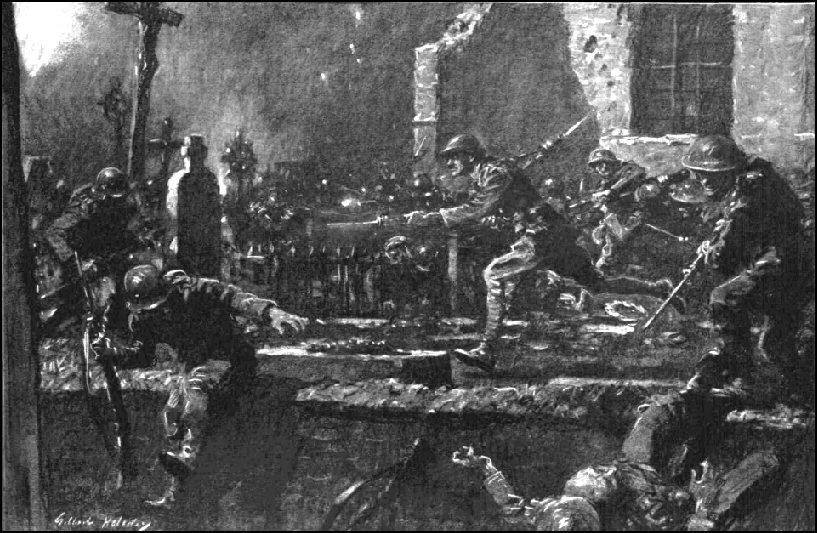
Major Roberts leading the counter attack at Pargny - 9.0 p.m. on the 23rd March 1918
After the recapture of Pargny the front of the 1st Worcestershire remained unchanged through-out the night; but dawn showed the situation to be serious. In front the enemy were massing in strength; away to the left the Sherwood Foresters were with difficulty holding back fierce onslaughts at St. Christ; on the right flank the 24th Division had retreated. The enemy had crossed the river at Bethencourt and were entering Morchain.

Major Frank Crowther Roberts V.C., D.S.O., O.B.E., M.C. medals
(Click here for a larger image of his medals)
Victoria Cross, Distinguished Service Order (D.S.O.), Officer of the Order of the British Empire (O.B.E.), Military Cross (M.C.), 1914 Star + clasp "5th Aug - 22nd Nov 1914", British War Medal (1914-20), Victory Medal (1914-19) with MiD oakleaf, British War Medal (1939-45), King George V Silver Jubilee Medal (1935), King George VI Coronation Medal (1937), Queen Elizabeth II Coronation Medal (1953), Queen Elizabeth II Silver Jubilee Medal (1977), The Medal of Order of Muhammad 'Ali - First Class Gold, The Khedive's Sudan Medal (Aliab Dinka), Order of El-Rafidain (Grand Officer), Nut al-Khidmat al-Awal (Iraqi General Service Medal).
On the 27th March 1918 at the Battle of Rosières, Acting Lieut.-Colonel Roberts was wounded and was compelled to go back to hospital the Adjutant, Captain W. C. Stevens was left in command. On the 17th June 1918 he returned to take command of the 1st Battalion again. Lieut.-Colonel Roberts was Mentioned in Despatches six times and during the 1914-18 War he was wounded three times. He was presented with his V.C. in the courtyard at Buckingham Palace by H.R.H. King George V.
After the WarAfter the 1914-18 War, he was seconded to the Egyptian Army on the 16th February 1919. On the 22nd January 1921 he attended Staff College. He was awarded the O.B.E. on the 27th January 1921. He then served in a variety of Staff appointments in Egypt, the Rhine Army and in the Far East, before transferring to the 2nd Battalion Royal Warwickshire Regiment on accelerated promotion on the 6th July 1927, as Major. He served with them in India, the Middle East. On the 18th February 1931 he was appointed G.S.O. 1 and attached to the Iraq Army. For his distinguished service in the operations in Southern Kurdistan during the period October 1930 to May 1931 he was awarded the rank of Brevet Lieutenant-Colonel (London Gazette 6th May 1932). He had married Winifred Margaret Wragg in 1932 at Burton upon Trent, Staffordshire. On the 6th May 1932 he was made a Brevet Colonel. |
Major Roberts receives his VC from H.R.H. King George V |
On the 3rd August 1934 he was awarded the ORDER OP AL RAFIDAIN, Insignia of the Fourth Class (Military Division), by His Majesty the King of Iraq, in recognition of valuable services (London Gazette 3rd August 1932).
Maj.-Gen. Roberts grave |
On the 22nd January 1935 he was made G.S.O. 2nd Grade (Staff Officer), Nothern Ireland District, a position he held until 24th November 1936. On the 24th November 1936 he was promoted to the substantive rank of Lieut.-Colonel. He was selected to command 1st Battalion The Royal Warwickshire Regiment in 1937. On the 9th April 1937 he was granted the local rank of Brigadier while commanding the Poona (Ind.) Brigade Area, and on the 10th March 1938 he was made Temporary Brigadier while commanding a Brigade in India. On the 8th November 1937 he relinquish the local rank of Brigadier. On the 10th March 1938 he was given the rank of Colonel. On the 1st June 1939 he was promoted to Major-General and made a Divisional Commander of 48th Infantry Division (T.A.) Amongst his many awards he also held the Gold Medal of the Order of Mohamid Ali (Egypt). |
Frank Crowther Roberts |
On retirement from the Army on the 16th December 1939, Major-General Roberts and his wife settled in Bretby and lived at "Four Winds", Bretby, near Burton-on-Trent, his wife's home. There were no children and Mrs. Roberts died in December 1980.
Major-General F. C. Roberts, V.C., D.S.O., O.B.E., M.C., died on the 12th January 1982, of at his home at Bretby, Burton-on-Trent, Staffordshire. He was aged 90 and prior to his death was the last living ex-member of The Worcestershire Regiment holding the Victoria Cross. He was buried in Bretby Churchyard. |
Inscription at the foot of the grave |
General Roberts's thoughts were always with his old Comrades in the Worcestershire Regiment. He bequeathed his medals to the Worcestershire Regiment Museum Trust and also left a handsome bequest to the Worcestershire Regiment. His medals are now on display at the Worcestershire Regiment Museum section within the Worcester City Museum and Art Gallery, Foregate Street, Worcester WR1 1DT.
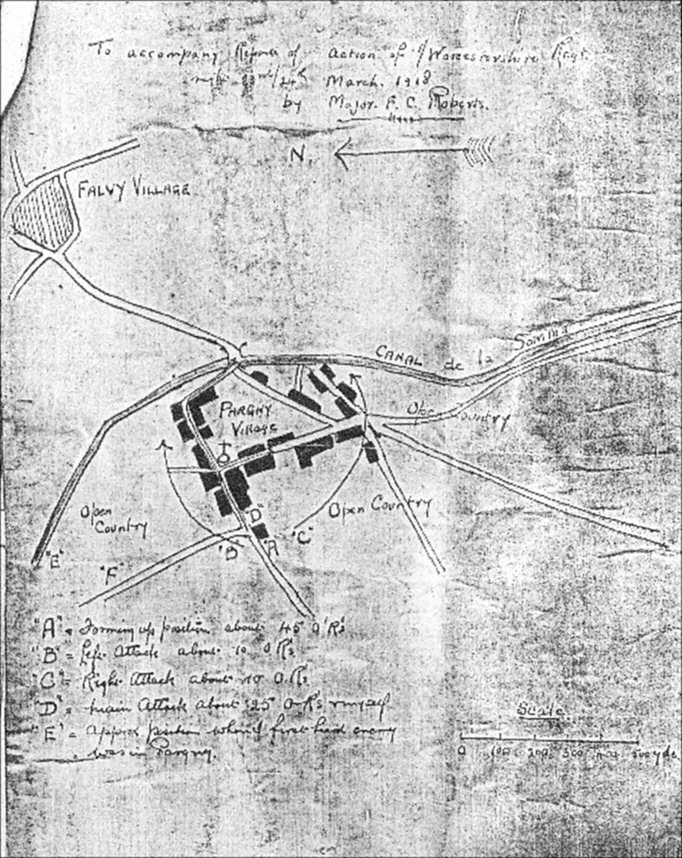
Actual map drawn by Maj.-Gen. Roberts V.C. of the
attack at Pargny

